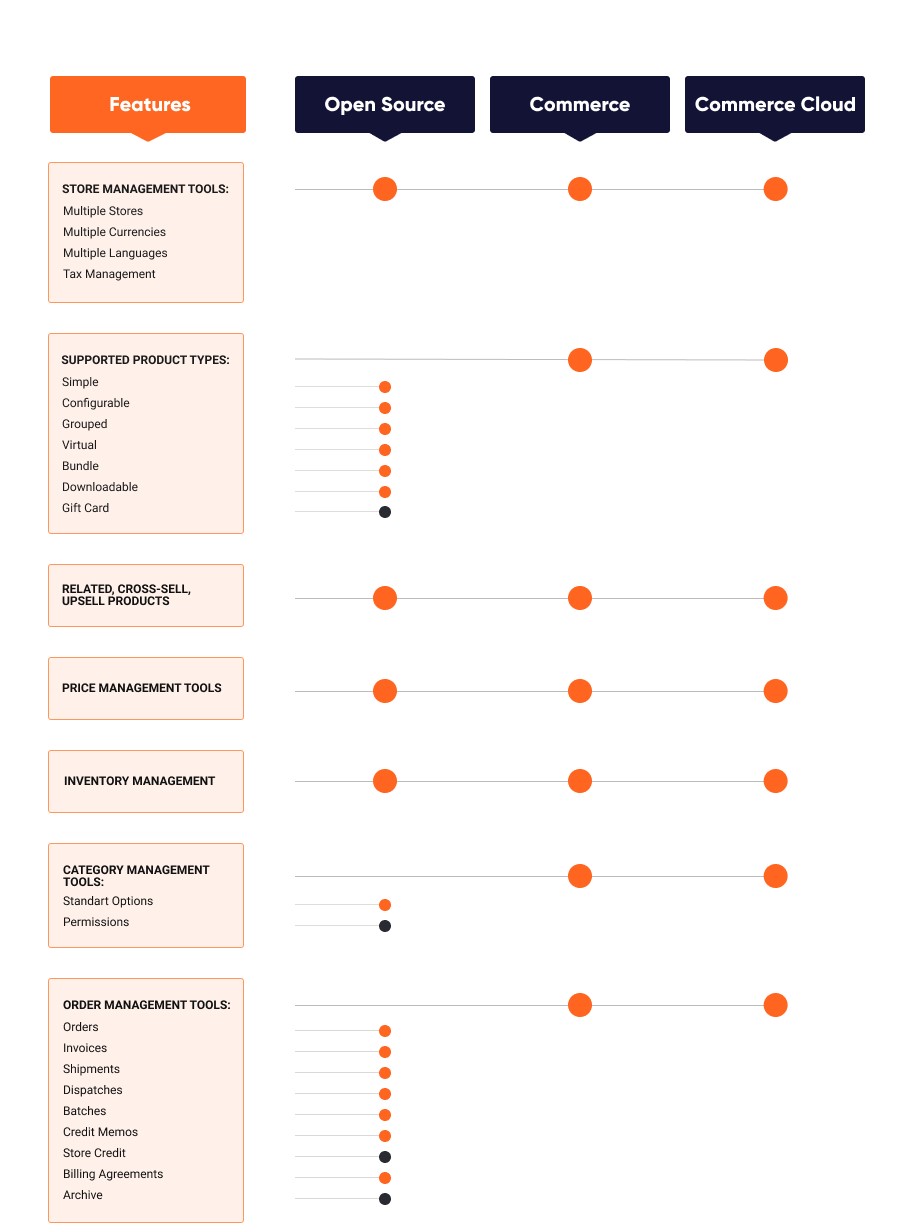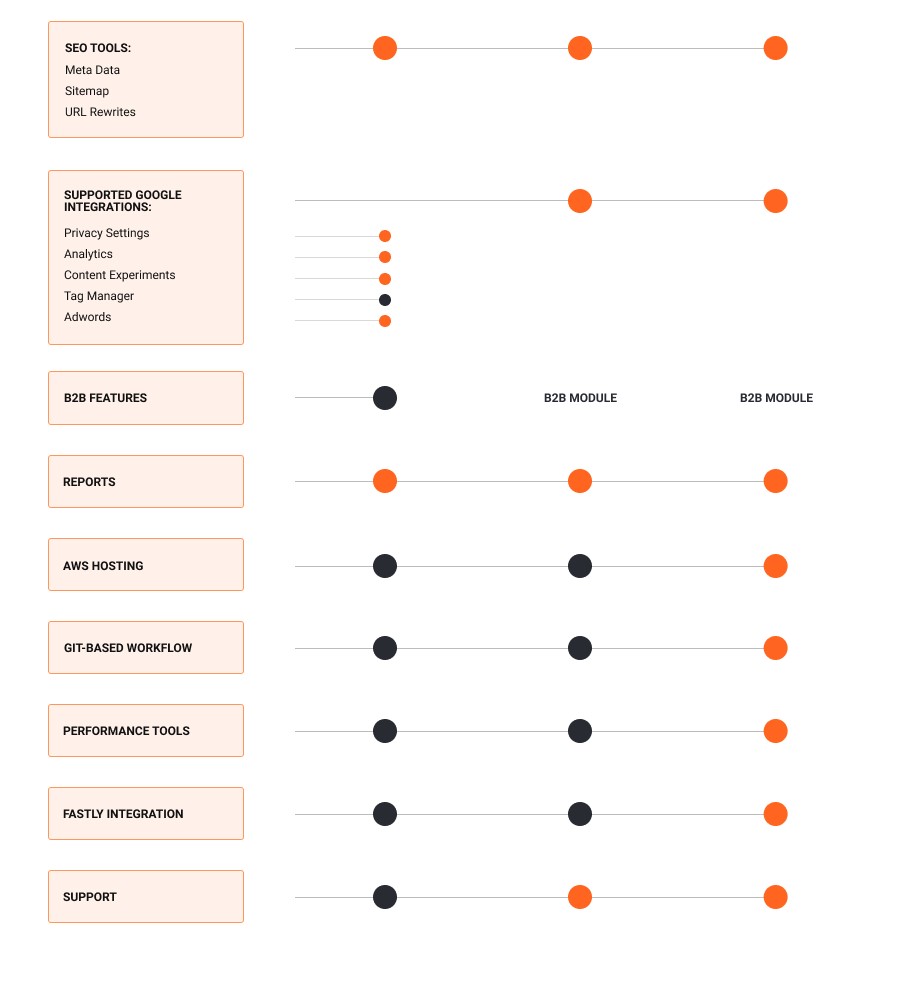- Magento Open Source vs. Adobe Commerce vs. Adobe Commerce Cloud
Magento Open Source vs. Adobe Commerce vs. Adobe Commerce Cloud
Once you have decided to open an online e-commerce store powered by Magento 2, you have to choose the most suitable edition: Magento Open Source, Adobe Commerce, or Adobe Commerce Cloud.
Each edition provides users with a specific set of features. So, the sure method to select a relevant edition is to identify your requirements and to relate them to the capabilities of Magento 2 Open Source, Commerce, and Commerce Cloud.
For this, let’s first consider these three editions one by one.
#1. Magento Open Source
Magento 2 Open Source Edition (formerly Magento 2 Community edition) is a Magento 2 platform that is available for everyone to download and install for free. Admin users can make configuration adjustments to the software to meet the specific requirements of their companies. To access particular advanced functionality, merchants can extend the basic features of Magento 2 Open Source Edition with specially designed modules, such as those listed in our catalog.
#2. Adobe Commerce
Adobe Commerce Edition (previously known as Magento 2 Enterprise, Magento 2 Commerce, or Magento Commerce On-Premise) gives users rich out-of-the-box features, an unlimited ability to customize, and seamless third-party integrations. It’s important that you can also get 24/7 email support. You cannot download Adobe Commerce for free.
Adobe Commerce contains features for corporate account management and customer support, company credit management, customized catalogs, and price lists, as well as tools for fast ordering and processing of online requests for quote.
Moreover, this Magento 2 edition offers one more outstanding feature – Content Staging – which allows creating, previewing, and scheduling a wide range of content updates directly from the Admin panel of your store. Content Staging can be used to create a dynamic page that changes automatically throughout the year on scheduled dates.
Commonly, Magento Open Source is not used for B2B as Magento 2 Commerce Edition suits more for B2B enterprises and stores with high customer traffic, large product catalogs, wide global presence, or high business complexity.
#3. Adobe Commerce Cloud Edition
Magento 2 Commerce Cloud Edition (earlier known as Enterprise Cloud Edition) is a managed and automated hosting platform specifically created for Cloud solutions. It can be called Magento self-hosted edition. This version includes all Magento 2 Commerce on-premise features and adds enhanced Cloud infrastructure hosting, which now includes Git integration and key environments for Magento Commerce Cloud development, staging, and live production. Put simply, the owners of this edition can code, test, and deploy across Integration, Staging, and Production environments to ensure a smooth performance of their stores.
Again, Magento Commerce Cloud Edition is more suitable for large companies with complex requirements as this edition is flexible enough to cover all of them and offers a powerful admin experience.
And now, let’s compare these editions feature to feature.
Magento 2 Open Source vs. Adobe Commerce
Both Magento 2 Open Source and Magento 2 Commerce have the following capabilities:
- Catalog Management;
- Marketing, Promotions and Conversion Tools;
- Customer Accounts;
- Checkout, Payment, and Shipping;
- Instant Purchase Checkout;
- Magento Shipping;
- Advanced Reporting powered by Magento Business Intelligence;
- Analytics and Reporting;
- Indexing, cart, and cache operations Improvements;
- Integrated dotdigital marketing automation software;
- Full Page Cache;
- Page Builder.
As for technology stack requirements, both editions support the latest versions of:
- web servers – Apache 2.4 and Nginx 1.8
- PHP 7.4, 8.1
- Varnish 6.x, 7.0
- MySQL 8.0
- Redis 5.0, 6.0, 6.2
- RabbitMQ 3.8, 3.9
- Elasticsearch 7.6+
There is a big difference between Magento Open Source and Commerce as Open Magento features are limited. Magento 2 Commerce exclusive features comprise:
- Catalog management (Category Permissions);
- Advanced marketing:
• Promotions (Dynamic Blocks, Related Product Rules)
• Merchandising (Visual Merchandiser, Gift Registry, Reward Points, Private Sales & Events (including countdown ticker), Store Credit, Gift Cards, Gift Wrap, Wishlist Search)
• Communications (Email Reminders)
• SEO & Search (Google Tag Manager)
- Content (Dynamic Blocks, Content Staging, Page Hierarchy);
- Customers (Customer Attributes, Customer Segments, Multiple WishLists per Customer);
- Sales (Order Archives, RMA, Assisted Shopping Cart Management);
- Reports based on Private Sales, WishLists, and Segments;
- B2B features (Shared Catalogs, Company Credit, Company Accounts, Quick Orders by SKU or Product Name, Quotes, Payment on Account, Requisition Lists).
A full feature list is available here.
Three selected features make Magento 2 Commerce special:
- Product Recommendations is a marketing tool that is powered by Adobe Sensei. It uses AI and machine learning to analyze customers’ behavior and catalog data and make personalized offers.
- Site-Wide Analysis Tool (SWAT) checks site performance, generates reports, and provides user with recommendations for performance improvement.
- Live Search is a ne search tool that is power by Adobe Sensei. It uses AI and and machine-learning to analyze visitor data and provide users with more relevant, and personalized search results.
Comparing Adobe Commerce vs. Open source, you can see that Commerce Edition comprises much more features. Still, the latter is more customizable and empowers merchants to add the needed functionality with extensions. This makes you free to decide for which features to pay. If you do not need the whole list of Magento 2 Commerce features, pick only those that really matter for your business.
Adobe Commerce vs. Adobe Commerce Cloud
Adobe Commerce Cloud is a Platform-as-a-Service (PaaS) built on a redundant AWS-based cloud hosting infrastructure. Unlike traditional SaaS e-commerce platforms, Magento Enterprise Cloud Edition is highly customizable, scalable, and considerably simplifies integration with third-party systems.
The platform comes with top-notch DevOps, release, and cloud management tools and comprises all the features of Adobe Commerce.
We picked up several key advantages of Adobe Commerce Cloud:
- Fully configured environment. You do not need to care about server configuration with the correct version of server software, PHP, or database software compatibility with Magento 2. The only crucial thing to watch is a proper configuration of access to folders and files. If there is a necessity, additional tools can be pre-installed (for example, Elastic Engine). As you see, Adobe Commerce Cloud simplifies server administration.
- Integrated source control management system (GIT) with the support for eight environments to develop, test, and launch your store:
• Integration. The Integration environment set comprises three testable environments, each of which incorporates an active Git branch, a database, a web server, caching, services, environment variables, and configurations.
• Staging. As code and extensions pass your tests, you can merge your Integration branch to a Staging environment, which becomes your pre-production testing environment. It includes a staging active branch, a database, a web server, caching, services, environment variables, configurations, and services, such as Fastly and New Relic.
• Production. When code is ready and tested, all code merges to master for deployment to the Production live site. This environment comprises your active master branch, a database, a web server, caching, third-party services, environment variables, and configurations.
• Inactive. You can have an unlimited number of inactive branches.
- Infrastructure-as-a-Service (IaaS). Virtual Infrastructure for Production and Staging environments with a three-server setup and dedicated hardware allows you to get a high level of reliability and availability.
Such a system will help to configure the staging environment to test the extensions installed or any code changes with no effect on a live server. For sure, someone can argue that it’s possible to deploy a new instance, however, it is extremely labor- and time-consuming as you again need a server administrator for deployment and maintenance. Moreover, an integrated source control management system stores all the changes, which allows rollback and guarantees the simplicity of tracking changes.
The advanced technologies used in Adobe Commerce Cloud deserve to be treated as advantages too:
- Fastly for CDN, web application firewall (WAF) and caching (based on Varnish);
- Blackfire Profiler for performance testing;
- New Relic APM for performance testing;
- Rabbit MQ job queue framework;
- GitHub (if you need a Git repo);
- Bitbucket (if you need a Git repo).
Among other benefits, automated patching and image optimization should be mentioned.
A Final Word
In conclusion, we want to summarize all said above in one infographic, where you can see the difference between Magento Open Source, Commerce, and Commerce Cloud:



While choosing a Magento 2 edition, we recommend paying attention to business volume, costs, and the relevancy of customer support as key factors. Whichever Magento inc edition you choose, we hope that you’ll love the flexibility of Magento 2 – just as we do!
Need a hand with custom development on Magento Open Source? Our team will be happy to help you out. Learn more →










Login and Registration Form